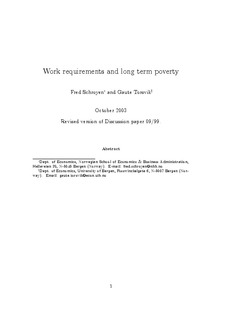| dc.contributor.author | Schroyen, Fred | |
| dc.contributor.author | Torsvik, Gaute | |
| dc.date.accessioned | 2006-08-07T07:39:37Z | |
| dc.date.available | 2006-08-07T07:39:37Z | |
| dc.date.issued | 1999 | |
| dc.identifier.issn | 0804-6824 | |
| dc.identifier.uri | http://hdl.handle.net/11250/162808 | |
| dc.description | Revised October 2003 | en |
| dc.description.abstract | We study how work requirements can be used to target transfers to
the long term poor. Without commitment, time consistency requires all
screening measures to be concentrated in the first phase of the program.
We show that this increases the effectiveness of workfare; it is optimal to
use work requirements for a wider range of prior beliefs about the size
of the poor population, and work requirements are used more intensively.
We compare these results with the optimal policy under commitment. | en |
| dc.format.extent | 491419 bytes | |
| dc.format.mimetype | application/pdf | |
| dc.language.iso | eng | en |
| dc.publisher | Norwegian School of Economics and Business Administration. Department of Economics | en |
| dc.relation.ispartofseries | Discussion paper | en |
| dc.relation.ispartofseries | 1999:9 | en |
| dc.subject | long-term poverty | en |
| dc.subject | ratchet effect | en |
| dc.subject | screening | en |
| dc.title | Work requirements and long term poverty | en |
| dc.type | Working paper | en |
